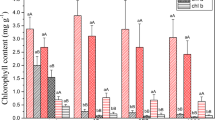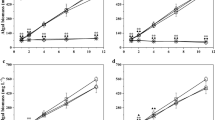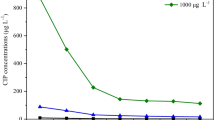Abstract
Tetracyclines are frequently detected in water bodies due to their widespread use in aquaculture and animal husbandry. A hydroponic experiment was conducted to explore the phytotoxic effects of Vallisneria natans (Lour.) Hare exposed to various concentrations of chlortetracycline (CTC) and oxytetracycline (OTC) (0, 0.1, 1, 10, 30, 50, and 100 mg/L) for 7 days (7 D) and 14 days (14 D), respectively. The results showed that similar to OTC treatment for 7 D, the relative growth rates (RGR) and catalase (CAT) activity of V. natans, after 7 D of CTC exposure, decreased significantly at 10 mg/L and 30 mg/L, respectively. The content of soluble protein notably decreased when CTC ≥ 10 mg/L and OTC ≥ 30 mg/L. The hydrogen peroxide (H2O2) content was significantly stimulated when OTC ≥ 10 mg/L, while it hardly changed when exposed to CTC. After 14 D, the malondialdehyde (MDA) and H2O2 contents of V. natans were significantly higher than those of the control group under a high concentration of OTC (≥ 30 mg/L), but they did not change significantly under a high concentration of CTC. The activity of polyphenol oxidase (PPO), under CTC treatment after 14 D, showed first a significant increase then decreases; the maximum value (125% of the control) was noticed at 10 mg/L CTC, while it remained unchanged when exposed to OTC. The soluble protein content significantly decreased at 10 mg/L CTC and 0.1 mg/L OTC, respectively. The RGR, CAT, and peroxidase (POD) activities, similar to OTC treatment after 14 D, decreased evidently when CTC was 10 mg/L, 30 mg/L, and 0.1 mg/L, respectively. CTC and OTC harm the chlorophyll content of V. natans after 14 D, and the reductions of chlorophyll a and carotenoid were more pronounced than chlorophyll b. The results suggest that CTC and OTC both have a negative effect on the growth of V. natans, and OTC can cause oxidative damage in V. natans but CTC harms the metabolism process without inducing oxidative damage. Overall, the toxicity of OTC to V. natans is stronger than that of CTC.






Similar content being viewed by others
Data availability
All data generated or analyzed during this study are included in this published article.
References
Anchordoquy JM, Anchordoquy JP, Nikoloff N, Gambaro R, Padula G, Seoane A, Furnus C (2019) Doramectin induced cytotoxic and genotoxic effects on bovine peripheral lymphocytes and cumulus cells in vitro. J Environ Sci Heal B 54:147–154. https://doi.org/10.1080/03601234.2018.1559569
Bártíková H, Podlipná R, Skálová L (2016) Veterinary drugs in the environment and their toxicity to plants. Chemosphere 144:2290–2301. https://doi.org/10.1016/j.chemosphere.2015.10.137
Bradford M (1976) A rapid and sensitive method for the quantitation of microgram quantities of protein utilizing the principles of protein-dye binding. Anal Biochem 71:248–254
Brain RA, Wilson CJ, Johnson DJ, Sanderson H, Bestari K(J), Hanson ML, Sibley PK, Solomon KR (2005) Effects of a mixture of tetracyclines to Lemna gibba and Myriophyllum sibiricum evaluated in aquatic microcosms. Environ Pollut 138:425–442. https://doi.org/10.1016/j.envpol.2005.04.021
Cabello FC, Godfrey HP, Tomova A, Ivanova L, Dölz H, Millanao A, Buschmann AH (2013) Antimicrobial use in aquaculture re-examined: its relevance to antimicrobial resistance and to animal and human health. Environ Microbiol 15:1917–1942. https://doi.org/10.1111/1462-2920.12134
Cang J, Zhao H (2013) Experimental course of plant physiology. Higher Education press, Peking, pp 151–153 (in Chinese)
Carusso S, Juárez AB, Moretton J, Magdaleno A (2018) Effects of three veterinary antibiotics and their binary mixtures on two green alga species. Chemosphere 194:821–827. https://doi.org/10.1016/j.chemosphere.2017.12.047
Chen H, Jing L, Teng Y, Wang J (2018) Characterization of antibiotics in a large-scale river system of China: occurrence pattern, spatiotemporal distribution and environmental risks. Sci Total Environ 618:409–418. https://doi.org/10.1016/j.scitotenv.2017.11.054
Cheng D, Liu X, Wang L, Gong W, Liu G, Fu W, Cheng M (2014) Seasonal variation and sediment–water exchange of antibiotics in a shallower large lake in North China. Sci Total Environ 476–477:266–275. https://doi.org/10.1016/j.scitotenv.2014.01.010
Chi Z, Liu R, Zhang H (2010) Potential enzyme toxicity of oxytetracycline to catalase. Sci Total Environ 408:5399–5404. https://doi.org/10.1016/j.scitotenv.2010.08.005
Christou A, Agüera A, Bayona JM, Cytryn E, Fotopoulos V, Lambropoulou D, Manaia CM, Michael C, Revitt M, Schröder P, Fatta-Kassinos D (2017) The potential implications of reclaimed wastewater reuse for irrigation on the agricultural environment: the knowns and unknowns of the fate of antibiotics and antibiotic resistant bacteria and resistance genes – a review. Water Res 123:448–467. https://doi.org/10.1016/j.watres.2017.07.004
Cui Y, Zhao N (2011) Oxidative stress and change in plant metabolism of maize (Zea mays L.) growing in contaminated soil with elemental sulfur and toxic effect of zinc. Plant Soil Environ 57:34–39. https://doi.org/10.17221/193/2010-PSE
Cui X, Qiao X, Han C, Wang Z (2008) Uptake of oxytetracycline and its phytotoxicity to lettuce. J Agro-Environ Sci 27:1038–1042 (in Chinese)
Dai Y, Li J, Shan D (2020) Adsorption of tetracycline in aqueous solution by biochar derived from waste Auricularia auricula dregs. Chemosphere 238:124432. https://doi.org/10.1016/j.chemosphere.2019.124432
Dhindsa RS, Plumb-Dhindsa P, Thorpe TA (1981) Leaf senescence: correlated with increased levels of membrane permeability and lipid peroxidation, and decreased levels of superoxide dismutase and catalase. J Exp Bot 32:93–101. https://doi.org/10.1093/jxb/32.1.93
Ding H, Wu Y, Zhang W, Zhong J, Lou Q, Yang P, Fang Y (2017) Occurrence, distribution, and risk assessment of antibiotics in the surface water of Poyang Lake, the largest freshwater lake in China. Chemosphere 184:137–147. https://doi.org/10.1016/j.chemosphere.2017.05.148
Dong L, Gao J, Xie X, Zhou Q (2012) DNA damage and biochemical toxicity of antibiotics in soil on the earthworm Eisenia fetida. Chemosphere 89:44–51. https://doi.org/10.1016/j.chemosphere.2012.04.010
Dutta J, Mala AA (2020) Removal of antibiotic from the water environment by the adsorption technologies: a review. Water Sci Technol 82:401–426. https://doi.org/10.2166/wst.2020.335
Fukushima Y, Tsuyuki Y, Goto M, Yoshida H, Takahashi T (2019) Species identification of β-hemolytic streptococci from diseased companion animals and their antimicrobial resistance data in Japan (2017). Jpn J Infect Dis 72:94–98. https://doi.org/10.7883/yoken.JJID.2018.231
Guo X, Liu M, Zhong H, Li P, Zhang C, Wei D, Zhao T (2020) Responses of the growth and physiological characteristics of Myriophyllum aquaticum to coexisting tetracyclines and copper in constructed wetland microcosms. Environ Pollut 261:114204. https://doi.org/10.1016/j.envpol.2020.114204
Halling-Sørensen B (2000) Algal toxicity of antibacterial agents used in intensive farming. Chemosphere 40:731–739. https://doi.org/10.1016/S0045-6535(99)00445-2
Han T, Liang Y, Wu Z, Zhang L, Liu Z, Li Q, Chen X, Guo W, Jiang L, Pan F, Ge S, Mi Z, Liu Z, Huang H, Li X, Zhou J, Li Y, Wang J, Zhang Z, Tang Y, Yang L, Wu M (2019) Effects of tetracycline on growth, oxidative stress response, and metabolite pattern of ryegrass. J Hazard Mater 380:120885. https://doi.org/10.1016/j.jhazmat.2019.120885
Hanson ML, Knapp CW, Graham DW (2006) Field assessment of oxytetracycline exposure to the freshwater macrophytes Egeria densa Planch. and Ceratophyllum demersum L. Environ Pollut 141:434–442. https://doi.org/10.1016/j.envpol.2005.08.068
Hoagland DR, Arnon DI (1950) The water-cultural method for growing plants without soil. Calif Agric Ext Serv Circ 347:29-31
Jampeetong A, Brix H (2009) Effects of NaCl salinity on growth, morphology, photosynthesis and proline accumulation of Salvinia natans. Aquat Bot 91:181–186. https://doi.org/10.1016/j.aquabot.2009.05.003
Jeong J, Song W, Cooper WJ, Jung J, Greaves J (2010) Degradation of tetracycline antibiotics: mechanisms and kinetic studies for advanced oxidation/reduction processes. Chemosphere 78:533–540. https://doi.org/10.1016/j.chemosphere.2009.11.024
Jiao S, Dou Y, Chen L, Pu H, Zheng S, Yin D (2008) Effect of aqueous tetracycline on Vallisneria natans in growth and ultrstructure. Environ Chem 27:335–338 (in Chinese). https://doi.org/10.3321/j.issn:0254-6108.2008.03.013
Kar RK, Choudhuri MA (1987) Possible mechanisms of light-induced chlorophyll degradation in senescing leaves of Hydrilla verticillata. Physiol Plant 70:729–734. https://doi.org/10.1111/j.1399-3054.1987.tb04331.x
Kasai K, Kanno T, Endo Y, Wakasa K, Tozawa Y (2004) Guanosine tetra- and pentaphosphate synthase activity in chloroplasts of a higher plant: association with 70S ribosomes and inhibition by tetracycline. Nucleic Acids Res 32:5732–5741. https://doi.org/10.1093/nar/gkh916
Kouka P, Chatzieffraimidi G-A, Raftis G, Stagos D, Angelis A, Stathopoulos P, Xynos N, Skaltsounis A-L, Tsatsakis AM, Kouretas D (2018) Antioxidant effects of an olive oil total polyphenolic fraction from a Greek Olea europaea variety in different cell cultures. Phytomedicine 47:135–142. https://doi.org/10.1016/j.phymed.2018.04.054
Kraus RL, Pasieczny R, Lariosa-Willingham K, Turner MS, Jiang A, Trauger JW (2005) Antioxidant properties of minocycline: neuroprotection in an oxidative stress assay and direct radical-scavenging activity. J Neurochem 94:819–827. https://doi.org/10.1111/j.1471-4159.2005.03219.x
Krzeminski P, Tomei MC, Karaolia P, Langenhoff A, Almeida CMR, Felis E, Gritten F, Andersen HR, Fernandes T, Manaia CM, Rizzo L, Fatta-Kassinos D (2019) Performance of secondary wastewater treatment methods for the removal of contaminants of emerging concern implicated in crop uptake and antibiotic resistance spread: a review. Sci Total Environ 648:1052–1081. https://doi.org/10.1016/j.scitotenv.2018.08.130
Li X, Cui K, Guo Z, Yang T, Cao Y, Xiang Y, Chen H, Xi M (2020) Heterogeneous Fenton-like degradation of tetracyclines using porous magnetic chitosan microspheres as an efficient catalyst compared with two preparation methods. Chem Eng J 379:122324. https://doi.org/10.1016/j.cej.2019.122324
Lichtenthaler HK (1987) Chlorophylls and carotenoids: pigments of photosynthetic biomembranes. Methods Enzymol:350–382
Lin L, Yuan K, Liang X, Chen X, Zhao Z, Yang Y, Zou S, Luan T, Chen B (2015) Occurrences and distribution of sulfonamide and tetracycline resistance genes in the Yangtze River Estuary and nearby coastal area. Mar Pollut Bull 100:304–310. https://doi.org/10.1016/j.marpolbul.2015.08.036
Liu P, Li M (2007) Experimental techniques of plant physiology. Science Press, Peking, pp 123–125 (in Chinese)
Liu N, Wu Z (2018) Growth and antioxidant response in Ceratophyllum demersum L. under sodium dodecyl sulfate (SDS), phenol and joint stress. Ecotoxicol Environ Saf 163:188–195. https://doi.org/10.1016/j.ecoenv.2018.07.074
Liu D, Lu L, Luo W, Tian S, Yang X (2017) Degradation of tetracyclines in soils and their effects on root growth of Chinese cabbages (Brassica campestris L.). Acta Sci Circumst 37:1957–1966 (in Chinese)
Liu N, Zhong G, Zhou J, Liu Y, Pang Y, Cai H, Wu Z (2019) Separate and combined effects of glyphosate and copper on growth and antioxidative enzymes in Salvinia natans (L.) All. Sci Total Environ 655:1448–1456. https://doi.org/10.1016/j.scitotenv.2018.11.213
Liu Y, Pang Y, Yang L, Ning S, Wang D, Wu Z (2020) Responses of Hydrocharis dubia (Bl.) Backer and Trapa bispinosa roxb. to tetracycline exposure. Ecotoxicol Environ Saf 202:110890. https://doi.org/10.1016/j.ecoenv.2020.110890
Lu L, Wu Y, Ding H, Zhang W (2015) The combined and second exposure effect of copper (II) and chlortetracycline on fresh water algae, Chlorella pyrenoidosa and Microcystis aeruginosa. Environ Toxicol Pharmacol 40:140–148. https://doi.org/10.1016/j.etap.2015.06.006
Maged A, Iqbal J, Kharbish S, Ismael IS, Bhatnagar A (2020) Tuning tetracycline removal from aqueous solution onto activated 2:1 layered clay mineral: characterization, sorption and mechanistic studies. J Hazard Mater 384:121320. https://doi.org/10.1016/j.jhazmat.2019.121320
Mathews S, Reinhold D (2013) Biosolid-borne tetracyclines and sulfonamides in plants. Environ Sci Pollut Res 20:4327–4338. https://doi.org/10.1007/s11356-013-1693-y
Matsui Y, Ozu T, Inoue T, Matsushita T (2008) Occurrence of a veterinary antibiotic in streams in a small catchment area with livestock farms. Desalination 226:215–221. https://doi.org/10.1016/j.desal.2007.01.243
Mayer AM (2006) Polyphenol oxidases in plants and fungi: going places? A review. Phytochemistry 67:2318–2331. https://doi.org/10.1016/j.phytochem.2006.08.006
Moro I, Trentin R, Moschin E, Dalla Vecchia F (2020) Morpho-physiological responses by Isochrysis galbana Parke to different concentrations of oxytetracycline. Environ Pollut 262:114273. https://doi.org/10.1016/j.envpol.2020.114273
Munns R (2002) Comparative physiology of salt and water stress. Plant Cell Environ 25:239–250. https://doi.org/10.1046/j.0016-8025.2001.00808.x
Nkoom M, Lu G, Liu J (2018) Occurrence and ecological risk assessment of pharmaceuticals and personal care products in Taihu Lake, China: a review. Environ Sci Process Impacts 20:1640–1648. https://doi.org/10.1039/c8em00327k
Nunes B, Antunes SC, Gomes R, Campos JC, Braga MR, Ramos AS, Correia AT (2015) Acute Effects of tetracycline exposure in the freshwater fish Gambusia holbrooki: antioxidant effects, neurotoxicity and histological alterations. Arch Environ Contam Toxicol 68:371–381. https://doi.org/10.1007/s00244-014-0101-z
Olette R, Couderchet M, Biagianti S, Eullaffroy P (2008) Toxicity and removal of pesticides by selected aquatic plants. Chemosphere 70:1414–1421. https://doi.org/10.1016/j.chemosphere.2007.09.016
Pham DK, Chu J, Do NT, Brose F, Degand G, Delahaut P, De Pauw E, Douny C, Van Nguyen K, Vu TD, Scippo ML, Wertheim HFL (2015) Monitoring antibiotic use and residue in freshwater aquaculture for domestic use in Vietnam. Ecohealth 12:480–489. https://doi.org/10.1007/s10393-014-1006-z
Rydzyński D, Piotrowicz-Cieślak AI, Grajek H, Wasilewski J (2019) Investigation of chlorophyll degradation by tetracycline. Chemosphere 229:409–417. https://doi.org/10.1016/j.chemosphere.2019.05.035
Shi H (2016) Experimental guidance of plant stress physiology. Science Press, Peking, pp 58–75 (in Chinese)
Siedlewicz G, Żak A, Sharma L, Kosakowska A, Pazdro K (2020) Effects of oxytetracycline on growth and chlorophyll a fluorescence in green algae (Chlorella vulgaris), diatom (Phaeodactylum tricornutum) and cyanobacteria (Microcystis aeruginosa and Nodularia spumigena). Oceanologia 62:214–225. https://doi.org/10.1016/j.oceano.2019.12.002
Singh S, Eapen S, D’Souza SF (2006) Cadmium accumulation and its influence on lipid peroxidation and antioxidative system in an aquatic plant, Bacopa monnieri L. Chemosphere 62:233–246. https://doi.org/10.1016/j.chemosphere.2005.05.017
Singh S, Melo JS, Eapen S, D’Souza SF (2008) Potential of vetiver (Vetiveria zizanoides L. Nash) for phytoremediation of phenol. Ecotoxicol Environ Saf 71:671–676. https://doi.org/10.1016/j.ecoenv.2007.10.023
Song G, Gao Y, Wu H, Hou W, Zhang C, Ma H (2012) Physiological effect of anatase TiO2 nanoparticles on Lemna minor. Environ Toxicol Chem 31:2147–2152. https://doi.org/10.1002/etc.1933
Takahashi S, Murata N (2008) How do environmental stresses accelerate photoinhibition? Trends Plant Sci 13:178–182. https://doi.org/10.1016/j.tplants.2008.01.005
Tongaree S, Flanagan DR, Poust RI (1999) The interaction between oxytetracycline and divalent metal ions in aqueous and mixed solvent systems. Pharm Dev Technol 4:581–591
Wang C, Zhang SH, Wang PF, Hou J, Li W, Zhang WJ (2008) Metabolic adaptations to ammonia-induced oxidative stress in leaves of the submerged macrophyte Vallisneria natans (Lour.) Hara. Aquat Toxicol 87:88–98. https://doi.org/10.1016/j.aquatox.2008.01.009
Wang C, Zhang S, Wang P, Hou J, Qian J, Ao Y, Lu J, Li L (2011) Salicylic acid involved in the regulation of nutrient elements uptake and oxidative stress in Vallisneria natans (Lour.) Hara under Pb stress. Chemosphere 84:136–142. https://doi.org/10.1016/j.chemosphere.2011.02.026
Wang Z, Du Y, Yang C, Liu X, Zhang J, Li E, Zhang Q, Wang X (2017) Occurrence and ecological hazard assessment of selected antibiotics in the surface waters in and around Lake Honghu, China. Sci Total Environ 609:1423–1432. https://doi.org/10.1016/j.scitotenv.2017.08.009
Wu Z, Yu D, Li J, Wu G, Niu X (2010) Growth and antioxidant response in Hydrocharis dubis (Bl.) Backer exposed to linear alkylbenzene sulfonate. Ecotoxicology 19:761–769. https://doi.org/10.1007/s10646-009-0453-8
Xie X, Zhou Q, Lin D, Guo J, Bao Y (2011) Toxic effect of tetracycline exposure on growth, antioxidative and genetic indices of wheat (Triticum aestivum L.). Environ Sci Pollut Res 18:566–575. https://doi.org/10.1007/s11356-010-0398-8
Xie Z, Tang J, Wu X, Li X, Hua R (2019) Bioconcentration, metabolism and the effects of tetracycline on multiple biomarkers in Chironomus riparius larvae. Sci Total Environ 649:1590–1598. https://doi.org/10.1016/j.scitotenv.2018.08.371
Ye J, Du Y, Wang L, Qian J, Chen J, Wu Q, Hu X (2017) Toxin release of cyanobacterium Microcystis aeruginosa after exposure to typical tetracycline antibiotic contaminants. Toxins (Basel) 9:53. https://doi.org/10.3390/toxins9020053
Ye J, Huang C, Shang A, Xu C, Wu L (2020) Characteristics of toxin production and release in Microcystis aeruginosa exposed to three tetracycline antibiotics. Environ Sci Pollut Res 27:16798–16805. https://doi.org/10.1007/s11356-020-08253-x
Yonar ME (2012) The effect of lycopene on oxytetracycline-induced oxidative stress and immunosuppression in rainbow trout (Oncorhynchus mykiss, W.). Fish Shellfish Immunol 32:994–1001. https://doi.org/10.1016/j.fsi.2012.02.012
Zargar A, Taheri Mirghaed A, Mirzargar SS, Ghelichpour M, Yousefi M, Hoseini SM (2020) Dietary ginger administration attenuates oxidative stress and immunosuppression caused by oxytetracycline in rainbow trout (Oncorhynchus mykiss). Aquac Res 51:4215–4224. https://doi.org/10.1111/are.14763
Zhang M, Cao T, Ni L, Xie P, Li Z (2010) Carbon, nitrogen and antioxidant enzyme responses of Potamogeton crispus to both low light and high nutrient stresses. Environ Exp Bot 68:44–50. https://doi.org/10.1016/j.envexpbot.2009.09.003
Zhang D, Li Y, Shen C, Xiao D, Liu J, Zhao F, Xiong M (2019) Understanding the toxic effects of chlortetracyclineandits and its isomer degradation products on Scenedes⁃ mus obliquus. J Agro⁃Environ Sci 38:756–764. https://doi.org/10.11654/jaes.2018-0964
Zhao S, Liu X, Cheng D, Liu G, Liang B, Cui B, Bai J (2016) Temporal–spatial variation and partitioning prediction of antibiotics in surface water and sediments from the intertidal zones of the Yellow River Delta, China. Sci Total Environ 569–570:1350–1358. https://doi.org/10.1016/j.scitotenv.2016.06.216
Zhong G, Wu Z, Yin J, Chai L (2018) Responses of Hydrilla verticillata (L.f.) Royle and Vallisneria natans (Lour.) Hara to glyphosate exposure. Chemosphere 193:385–393. https://doi.org/10.1016/j.chemosphere.2017.10.173
Zhou W, Wang Y, Xiao H, Wang R, Qu L, Tang X (2007) Sensitivity of several marine microalga to antibiotics. J Wuhan Univ Sci Ed 53:249–254 (in Chinese). https://doi.org/10.1016/S1872-2075(07)60055-7
Zhou J, Wu Z, Yu D, Pang Y, Cai H, Liu Y (2018) Toxicity of linear alkylbenzene sulfonate to aquatic plant Potamogeton perfoliatus L. Environ Sci Pollut Res 25:32303–32311. https://doi.org/10.1007/s11356-018-3204-7
Zhu X, Ding D, Ru S, Tan X, Xie Q, Deng C, Xie Q (2018) Effects of Ca2+, tetracycline antibiotic monomers, complex solution and soil desorption solution on seed germination and root bud elongation of Chinese cabbage. Jiangsu Agric Sci 46:141–144 (in Chinese. https://doi.org/10.15889/j.issn.1002-1302.2018.17.036
Zhu L, Xu H, Xiao W, Lu J, Lu D, Chen X, Zheng X, Jeppesen E, Zhang W, Wang L (2020) Ecotoxicological effects of sulfonamide on and its removal by the submerged plant Vallisneria natans (Lour.) Hara. Water Res 170:115354. https://doi.org/10.1016/j.watres.2019.115354
Funding
The National Science Foundation of China (No. 31270410, No. 30970303)
The Scientific Research Project of Hubei Province Environmental Protection Department (2014HB07)
Author information
Authors and Affiliations
Contributions
Jing Li: conceptualization, methodology, resources, investigation, writing-original draft
Lu Yang: resources, validation
Zhonghua Wu: Supervision, project administration, funding acquisition
Corresponding author
Ethics declarations
Ethical approval
This article does not contain any studies with human participants or animals performed by any of the authors.
Consent to participate
No applicable.
Consent for publication
Written informed consent for publication was obtained from all participants.
Competing interests
The authors declare no competing interests.
Additional information
Responsible Editor: Gangrong Shi
Publisher’s note
Springer Nature remains neutral with regard to jurisdictional claims in published maps and institutional affiliations.
Rights and permissions
About this article
Cite this article
Li, J., Yang, L. & Wu, Z. Toxicity of chlortetracycline and oxytetracycline on Vallisneria natans (Lour.) Hare. Environ Sci Pollut Res 28, 62549–62561 (2021). https://doi.org/10.1007/s11356-021-14922-2
Received:
Accepted:
Published:
Issue Date:
DOI: https://doi.org/10.1007/s11356-021-14922-2




